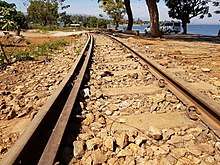Guard rail (rail)
In rail transport use, guard rails or check rails are placed parallel to regular running rail along areas of restricted clearance, such as a bridge, trestle, tunnel, or level crossing. These have the effect of keeping the wheels of rolling stock in alignment in case of derailment. It also helps to minimize damage to the structure and allows easier post-accident cleanup.

History
Although guard rails in some form have been used as long as there have been trains, the precursor of the guard rails we have today was detailed in U.S. Patent 522,038, filed in 1893 by Gorham B. Ames, based in Laconia, New Hampshire, USA.[1]
Sharp curves
On sharp curves, guard rails may be placed inside the inner rail, where they engage the back of the flange of the wheel on that side.[2]
References
| Wikimedia Commons has media related to Check rails. |
- US 522038, Ames, Gorham B., "Guard-rail", issued June 26, 1894
- "Mildura Train Derailment". The Argus. Melbourne. 27 August 1928. p. 16. Retrieved 5 August 2011 – via National Library of Australia.